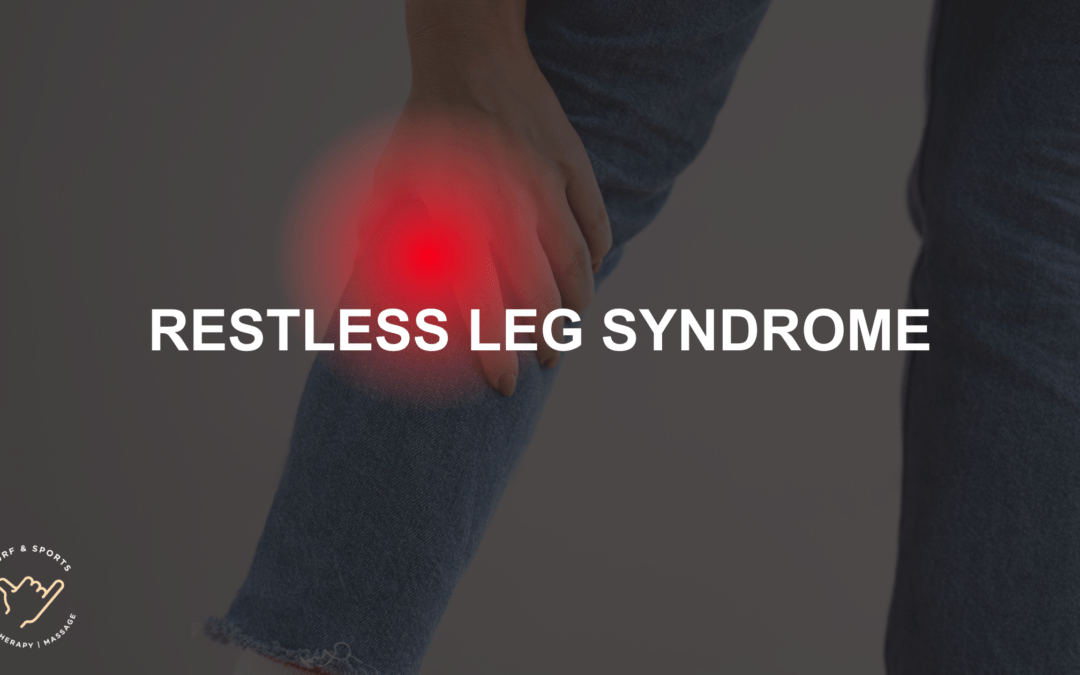If you’re one of the 10% of people struggling with Restless Leg Syndrome (RLS), you know how disruptive it can be.
The constant discomfort and sleepless nights leave you feeling drained and frustrated.
Myotherapy offers a natural way to ease RLS symptoms. It focuses on reducing the muscle tension that can trigger those restless sensations, helping you finally get the rest you need.
In this article, we’ll tackle the causes of RLS, and its symptoms, and explore how myotherapy can offer relief.
Causes and Symptoms of Restless Leg Syndrome
Restless Leg Syndrome (RLS) is a condition that affects many people. It causes discomfort and trouble sleeping. The true cause is not fully understood. Yet, some factors do make RLS symptoms worse.
Causes of RLS
Iron deficiency is seen as a possible cause of RLS. It affects how our brain and nervous system work. Low levels of iron in the brain change how dopamine works. Dopamine controls movements and feelings.
RLS can also be caused by chronic diseases. Conditions like kidney failure and diabetes can damage nerves and cause inflammation. This can lead to RLS. For some, RLS starts or gets worse during pregnancy’s last months.
The body goes through hormonal changes. There’s more blood, and nerves are under pressure. These can trigger RLS. Certain medications can also cause RLS. Drugs like some antidepressants may change dopamine levels. This can lead to RLS symptoms.
Symptoms of RLS
- An overwhelming urge to move your legs: This urge is particularly strong during rest and at night.
- Uncomfortable sensations: These may include throbbing, pulling, tingling, or a “crawling” feeling in your legs.
- Sleep disruption: The discomfort and urge to move make it difficult to fall asleep or stay asleep.
- Daytime fatigue: Poor sleep due to RLS can lead to feeling tired during the day.
Important Note: The severity and frequency of RLS symptoms can vary from person to person.
Treatment Options for Restless Leg Syndrome (RLS)
Restless Leg Syndrome (RLS) makes your legs feel strange and can disrupt your sleep. Luckily, there are many ways to help manage RLS. These options can help you sleep better and enjoy your days.
Myotherapy for RLS
- Myotherapy targets the root causes of your RLS discomfort. By releasing muscle tension and improving circulation in your legs, it reduces those restless sensations and the overwhelming urge to move. This promotes deeper, more restful sleep.
Image of the simple diagram of Primary RLS Areas. (Calves and thighs as common RLS areas. A basic outline of a leg with those areas shaded or highlighted.)
Example:
Lifestyle Changes
- Cut down on caffeine, alcohol, and smoking.
- Establish a regular sleep schedule and create a relaxing bedtime routine.
Supplements to Correct Deficiencies
- Discuss potential iron, folate, or magnesium supplements with your doctor.
Self-Care Practices
- Take warm baths or use warm compresses on your legs.
- Massage your legs, especially the calves.
Exercise
- Engage in regular activities like walking, biking, yoga, or swimming.
- Avoid intense exercise right before bed.
Other Strategies for Managing Restless Leg Syndrome
Besides myotherapy and lifestyle changes, other methods can help with RLS symptoms. Doing exercises gently makes a big difference. It improves the symptoms and helps you sleep better. You might enjoy cycling, yoga, and swimming as part of your daily activities.
These exercises help you get stronger and move better without hurting your legs. Try to exercise 30 to 60 minutes a day. But, avoid tough workouts right before bed. This might make your RLS worse.
When you ride a bike, go at a pace that feels comfortable for you. In yoga, choose poses that stretch you and relax you. Swimming is also great because it’s easy on the joints and can ease RLS symptoms a lot.
It’s important to find exercises that work for you. Talk to a doctor about what exercises are best for your RLS.
Conclusion
Myotherapy helps you break free from the cycle of restless nights caused by RLS. Addressing the underlying muscle tension promotes relaxation, reduces uncomfortable sensations, and helps you reclaim restful sleep.
Ready to experience the difference? Visit Surf & Sports Myotherapy and book your appointment today. Mention this blog post for a [insert small discount or special offer] on your first session!

